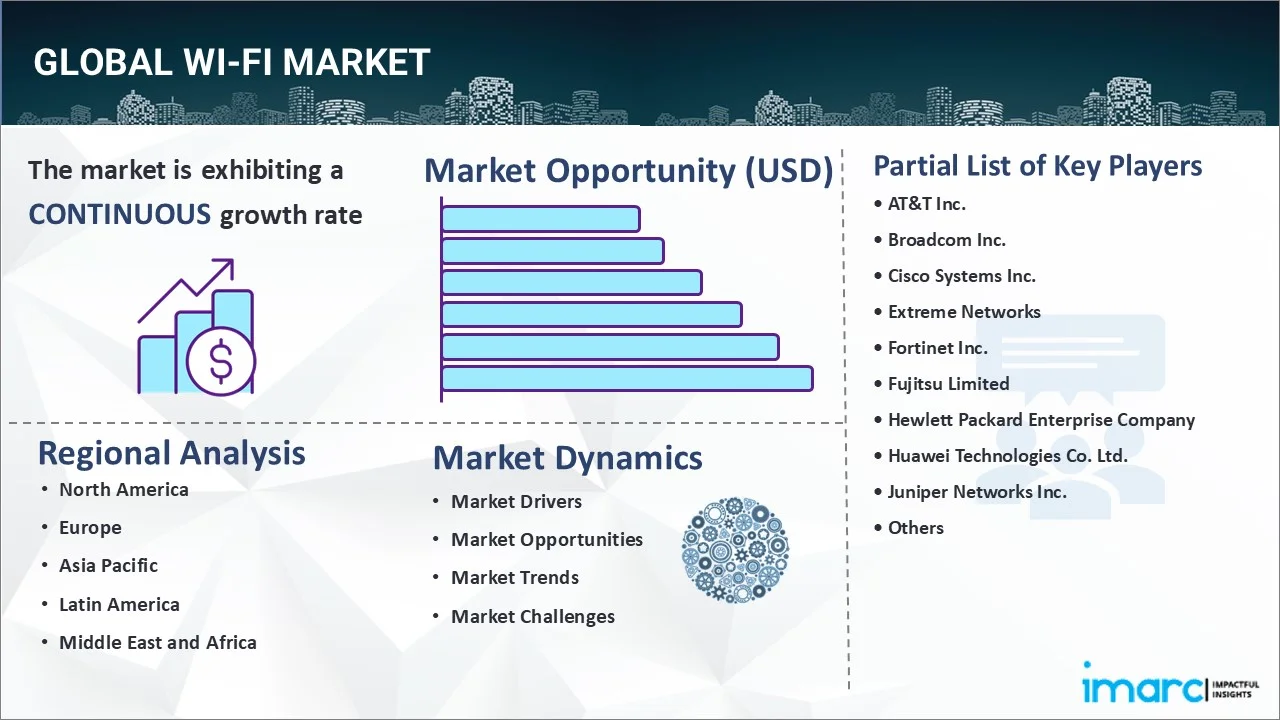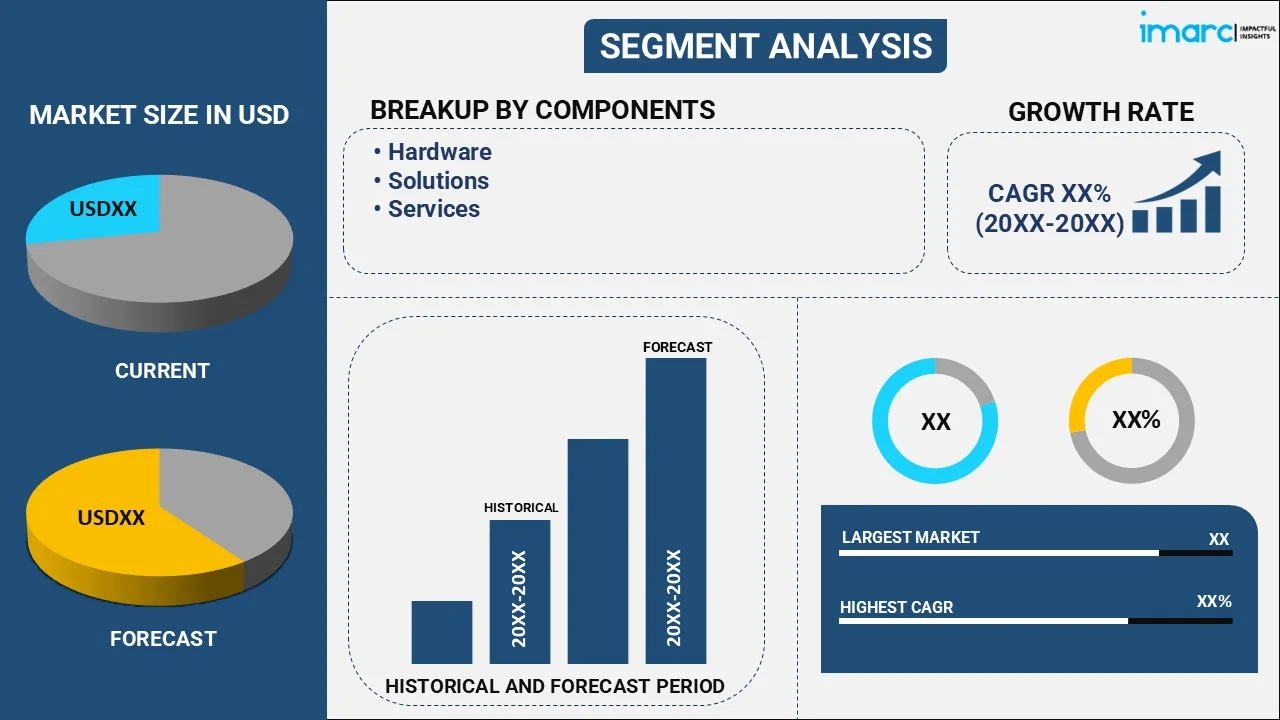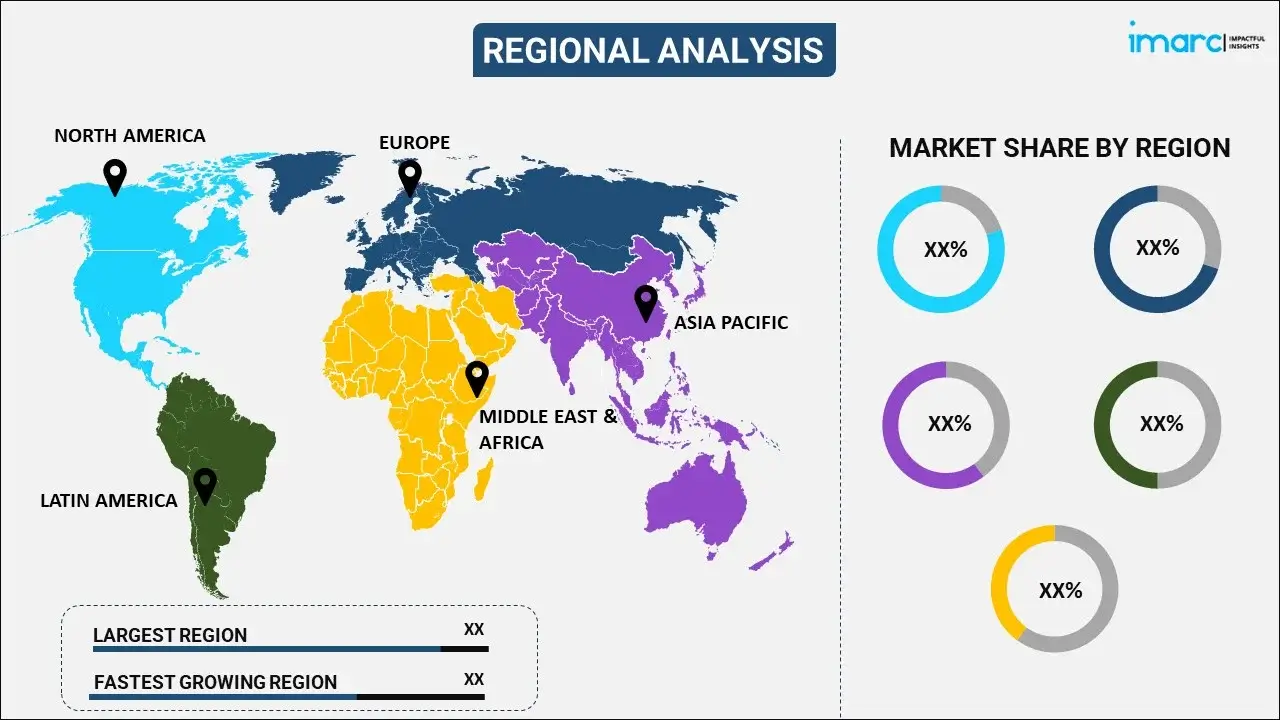
Wi-Fi Market Report by Component (Hardware, Solutions, Services), Density (High-Density Wi-Fi, Enterprise-Class Wi-Fi), Location Type (Indoor, Outdoor), Organization Size (Large Enterprises, Small and Medium-sized Enterprises), Industry Vertical (IT and Telecommunication, Education, BFSI, Healthcare, Logistics and Transportation, Retail, Government, and Others), and Region 2025-2033
Market Overview:
The global Wi-Fi market size reached USD 35.6 Billion in 2024. Looking forward, IMARC Group expects the market to reach USD 94.9 Billion by 2033, exhibiting a growth rate (CAGR) of 11.5% during 2025-2033. The increasing adoption of BYOD policies, rising need to share experiences and content on social media platforms, and the growing popularity of online gaming and esports are some of the major factors propelling the market.
|
Report Attribute
|
Key Statistics
|
|---|---|
|
Base Year
|
2024
|
|
Forecast Years
|
2025-2033
|
|
Historical Years
|
2019-2024
|
|
Market Size in 2024
|
USD 35.6 Billion |
|
Market Forecast in 2033
|
USD 94.9 Billion |
|
Market Growth Rate 2025-2033
|
11.5% |
Wireless fidelity (wi-fi) is a technological solution that allows devices like smartphones, laptops, and other electronics to connect over the internet and communicate with each other wirelessly using radio waves. It works on the 2.4 GHz and 5 GHz radio frequency bands, which provides high-speed data transmission between devices within its range. Its networks are created through wireless access points, such as routers, which transmit data between devices and the internet and enable convenient and flexible internet connectivity without the need for physical cables. It is widely used in homes, offices, public places, and various industries to connect devices to the internet and local networks.

The increasing adoption of bring your own device (BYOD) policies in workplaces encourages employees to use their personal devices, like smartphones and laptops, for work tasks, which is strengthening the growth of the market. Moreover, the rising need to share experiences and content on social media platforms is driving the demand for Wi-Fi in public places and events. In addition, the emergence of contemporary and smart homes with digital and electronic devices is favoring the growth of the market. Apart from this, the growing popularity of online gaming and esports that requires stable and high-speed Wi-Fi connections to ensure smooth gameplay is influencing the market positively. Furthermore, the increasing number of hotels, restaurants, and cafes that provide Wi-Fi to enhance guest experiences, facilitate online bookings, and enable digital services within their premises is propelling the growth of the market.
Wi-Fi Market Trends/Drivers:
Increase use of connected devices
The exponential increase in connected devices, such as smartphones, tablets, laptops, smart home appliances, and IoT devices, is fueling the demand for Wi-Fi connectivity. These devices rely on wireless networks to access the internet and communicate with each other seamlessly. As the adoption of these devices continues to surge globally, individuals and businesses seek reliable and high-speed Wi-Fi networks to support their diverse needs. The convenience of Wi-Fi enables users to access information, conduct transactions, and stay connected on-the-go, which makes it an essential feature in the digital landscape.
Rise in the development of smart cities
Rapid urbanization and the development of smart cities is catalyzing the demand for Wi-Fi infrastructure. In smart city initiatives, Wi-Fi forms the backbone of various interconnected systems, such as smart transportation, public safety, and municipal services. Citizens and businesses increasingly rely on Wi-Fi hotspots in public spaces, shopping centers, airports, and cafes for internet access while on the move. Wi-Fi-enabled technologies, like location-based services and indoor navigation, enhance user experiences and streamline operations in urban environments. As cities continue to embrace digital transformation, the demand for Wi-Fi is expected to grow, fostering innovation and improving overall quality of life for residents.
Expansion of Internet of Things (IoT)
The rapid expansion of IoT devices across various industries is a significant driver for Wi-Fi demand. IoT devices are embedded with sensors and connected to the internet, allowing them to exchange data and perform automated tasks. From smart homes and industrial automation to healthcare and agriculture, the proliferation of IoT applications relies heavily on Wi-Fi connectivity. These devices require seamless and secure wireless networks to function effectively. As businesses and individuals integrate more IoT devices into their daily operations and lifestyles, the need for robust Wi-Fi infrastructure becomes even more pronounced.
Wi-Fi Industry Segmentation:
IMARC Group provides an analysis of the key trends in each segment of the global Wi-Fi market report, along with forecasts at the global, regional and country levels from 2025-2033. Our report has categorized the market based on component, density, location type, organization size and industry vertical.
Breakup by Component:

- Hardware
- Solutions
- Services
Hardware dominates the market
The report has provided a detailed breakup and analysis of the market based on the component. This includes hardware, solutions, and services. According to the report, hardware represented the largest segment.
Wi-Fi hardware refers to the physical devices and equipment that enable wireless communication. It includes wireless routers, access points, network interface cards (NICs) in devices like laptops and smartphones, and Wi-Fi extenders. Routers and access points create Wi-Fi networks, while devices with Wi-Fi NICs can connect to these networks wirelessly. Wi-Fi hardware is designed to transmit and receive data using radio waves, which allows devices to communicate with each other and access the internet without the need for cables.
Wi-Fi solutions encompass the software and configurations used to manage and optimize Wi-Fi networks. It involves firmware and software in routers and access points that control network settings and security features. Wi-Fi solutions may also involve network management software that allows administrators to monitor and control the network, which ensures smooth performance and security. Wi-Fi solutions can vary based on the needs of the environment, such as home networks, enterprise networks, or public Wi-Fi hotspots.
Breakup by Density:
- High-Density Wi-Fi
- Enterprise-Class Wi-Fi
A detailed breakup and analysis of the market based on the density has also been provided in the report. This includes high-density Wi-Fi and enterprise-class Wi-Fi.
High-density Wi-Fi refers to a network setup designed to handle many Wi-Fi devices in a confined area. It is typically implemented in locations with a high concentration of users, such as stadiums, convention centers, airports, shopping malls, and other crowded public spaces.
On the other hand, enterprise-class Wi-Fi refers to Wi-Fi solutions specifically designed for businesses and organizations. It is usually deployed in corporate offices, campuses, hospitals, hotels, and other enterprise environments. Enterprise Wi-Fi systems feature more robust hardware, advanced security protocols, and sophisticated management tools compared to consumer-grade Wi-Fi routers.
Breakup by Location Type:
- Indoor
- Outdoor
Indoor dominates the market
The report has provided a detailed breakup and analysis of the market based on the location type. This includes indoor and outdoor. According to the report, indoor represented the largest segment.
Indoor Wi-Fi refers to wireless networks that are designed and deployed to provide internet connectivity and local network access within enclosed spaces or buildings. It is commonly found in homes, offices, schools, shopping malls, hospitals, airports, and other indoor environments. Its access points are usually installed on ceilings or walls to ensure optimal signal propagation that can be connected to a wired network or router, which acts as the internet gateway. Indoor Wi-Fi networks are essential for providing seamless internet access and connectivity to Wi-Fi-enabled devices like laptops, smartphones, tablets, and IoT devices within the building.
Outdoor Wi-Fi refers to wireless networks specifically designed for providing internet connectivity and coverage in outdoor spaces. It is commonly deployed in public parks, outdoor stadiums, city centers, outdoor cafes, and other open-air areas. Outdoor Wi-Fi access points are designed to withstand environmental factors like weather conditions and temperature fluctuations.
Breakup by Organization Size:
- Large Enterprises
- Small and Medium-sized Enterprises
A detailed breakup and analysis of the market based on the organization size has also been provided in the report. This includes large enterprises and small and medium-sized enterprises.
Wi-Fi networks in large enterprises cater to a substantial number of users and devices and support various applications and services. Large enterprise Wi-Fi networks require robust and scalable solutions. They consist of multiple access points deployed strategically throughout the premises to ensure comprehensive coverage. The network design can incorporate advanced features like virtual LANs (VLANs), Quality of Service (QoS), and centralized management platforms for better control and security. Security is of paramount importance in large enterprises, as these networks may hold sensitive business data and require protection against potential threats.
Wi-Fi solutions for SMEs are generally more straightforward and cost-effective compared to those for large enterprises. They can involve a single wireless router or access point that provides internet connectivity and local network access for employees' devices.
Breakup by Industry Vertical:
- IT and Telecommunication
- Education
- BFSI
- Healthcare
- Logistics and Transportation
- Retail
- Government
- Others
IT and telecommunication dominate the market
The report has provided a detailed breakup and analysis of the market based on the industry vertical. This includes IT and telecommunication, education, BFSI, healthcare, logistics and transportation, retail, government, and others. According to the report, IT and telecommunication represented the largest segment.
Wi-Fi plays a crucial role in the IT and telecommunication industry to provide seamless internet access to their employees and facilitate communication and collaboration. Telecommunication service providers also use Wi-Fi technology to offer public Wi-Fi hotspots to their customers, enabling internet connectivity in various public areas and enhancing customer satisfaction.
Wi-Fi has become an integral part of the education sectors as schools, colleges, and universities utilize Wi-Fi networks to provide internet access to students, teachers, and staff. Wi-Fi in educational settings supports online learning, research, and collaboration among students and educators. It also enables the use of educational technology and digital resources within the campus.
Wi-Fi is increasingly used in the BFSI sector to provide reliable and secure internet connectivity for both employees and customers. It facilitates day-to-day operations, communication, and data sharing among employees. It can be available for customers, which enables them to access banking services and information while visiting the bank premises.
Breakup by Region:

- North America
- United States
- Canada
- Asia-Pacific
- China
- Japan
- India
- South Korea
- Australia
- Indonesia
- Others
- Europe
- Germany
- France
- United Kingdom
- Italy
- Spain
- Russia
- Others
- Latin America
- Brazil
- Mexico
- Others
- Middle East and Africa
Asia Pacific exhibits a clear dominance, accounting for the largest Wi-Fi market share
The report has also provided a comprehensive analysis of all the major regional markets, which includes North America (the United States and Canada); Asia Pacific (China, Japan, India, South Korea, Australia, Indonesia, and Others); Europe (Germany, France, the United Kingdom, Italy, Spain, Russia, and Others); Latin America (Brazil, Mexico, and Others); and the Middle East and Africa. According to the report, Asia Pacific accounted for the largest market share.
The increasing penetration of the internet and a considerable reliance on smartphones represents one of the primary factors driving the demand for Wi-Fi in the Asia Pacific region. Moreover, the rising development of smart cities with easy access to Wi-Fi for supporting the healthcare and education sectors is favoring the growth of the market in the region. Apart from this, the growing investment on transportation, public safety, utilities, and education-related projects is influencing the market positively in the region.
Europe is estimated to witness stable growth, owing to the preference for autonomous vehicles, integration of advanced technologies, government initiatives, etc.
Competitive Landscape:
The leading companies are incorporating the use of beamforming and beam steering technologies, which enable access points to dynamically focus and direct signals to connected devices and ensure a stable and optimized connection. Moreover, key players are introducing Wi-Fi 6 that is designed to address the increasing demand for faster and more reliable connections. It introduces various improvements over its predecessor, Wi-Fi 5 (802.11ac), including increased data rates, higher capacity, and improved efficiency in handling multiple devices simultaneously. These technologies enable low-power connections and extended battery life for IoT devices while maintaining seamless connectivity. Besides this, the integration of multi-user, multiple-input, multiple-output (MU-MIMO) that allows access points to communicate with multiple devices simultaneously, improving network efficiency in crowded environments. Wi-Fi networks can better support multiple users and devices without sacrificing performance with MU-MIMO.
The report has provided a comprehensive analysis of the competitive landscape in the market. Detailed profiles of all major companies have also been provided. Some of the key players in the market include:
- AT&T Inc.
- Broadcom Inc.
- Cisco Systems Inc.
- Extreme Networks
- Fortinet Inc.
- Fujitsu Limited
- Hewlett Packard Enterprise Company
- Huawei Technologies Co. Ltd.
- Juniper Networks Inc.
- Motorola Solutions Inc.
- Panasonic Corporation
- Singapore Telecommunications Limited
- Telefonaktiebolaget LM Ericsson
- Telstra Corporation Limited
- Ubiquiti Inc
Recent Developments:
- In February 2022, Juniper Networks Inc. acquired WiteSand, an innovator of cloud-native zero trust Network Access Control (NAC) solutions. This acquisition brings a highly experienced engineering team and exceptional technology to the company, accelerating its ongoing efforts to deliver a next-generation NAC solution as a key element of their award-winning AI-driven enterprise portfolio.
- In January 2021, Extreme Networks acquired Infovista to expand its portfolio and offer new cloud-managed SD-WAN and security software solutions required to power the Infinite Enterprise.
Wi-Fi Market Report Scope:
| Report Features | Details |
|---|---|
| Base Year of the Analysis | 2024 |
| Historical Period | 2019-2024 |
| Forecast Period | 2025-2033 |
| Units | Billion USD |
| Scope of the Report | Exploration of Historical and Forecast Trends, Industry Catalysts and Challenges, Segment-Wise Historical and Predictive Market Assessment:
|
| Components Covered | Hardware, Solutions, Services |
| Densities Covered | High-Density Wi-Fi, Enterprise-Class Wi-Fi |
| Location Types Covered | Indoor, Outdoor |
| Organization Sizes Covered | Large Enterprises, Small and Medium-sized Enterprises |
| Industry Verticals Covered | IT and Telecommunication, Education, BFSI, Healthcare, Logistics and Transportation, Retail, Government, Others |
| Regions Covered | Asia Pacific, Europe, North America, Latin America, Middle East and Africa |
| Countries Covered | United States, Canada, Germany, France, United Kingdom, Italy, Spain, Russia, China, Japan, India, South Korea, Australia, Indonesia, Brazil, Mexico |
| Companies Covered | AT&T Inc., Broadcom Inc., Cisco Systems Inc., Extreme Networks, Fortinet Inc., Fujitsu Limited, Hewlett Packard Enterprise Company, Huawei Technologies Co. Ltd., Juniper Networks Inc., Motorola Solutions Inc., Panasonic Corporation, Singapore Telecommunications Limited, Telefonaktiebolaget LM Ericsson, Telstra Corporation Limited, Ubiquiti Inc. etc. |
| Customization Scope | 10% Free Customization |
| Post-Sale Analyst Support | 10-12 Weeks |
| Delivery Format | PDF and Excel through Email (We can also provide the editable version of the report in PPT/Word format on special request) |
Key Benefits for Stakeholders:
- IMARC’s report offers a comprehensive quantitative analysis of various market segments, historical and current market trends, market forecasts, and dynamics of the Wi-Fi market from 2019-2033.
- The research study provides the latest information on the market drivers, challenges, and opportunities in the global Wi-Fi market.
- The study maps the leading, as well as the fastest-growing, regional markets. It further enables stakeholders to identify the key country-level markets within each region.
- Porter's five forces analysis assist stakeholders in assessing the impact of new entrants, competitive rivalry, supplier power, buyer power, and the threat of substitution. It helps stakeholders to analyze the level of competition within the Wi-Fi industry and its attractiveness.
- Competitive landscape allows stakeholders to understand their competitive environment and provides an insight into the current positions of key players in the market.
Key Questions Answered in This Report
The global Wi-Fi market was valued at USD 35.6 Billion in 2024.
We expect the global Wi-Fi market to exhibit a CAGR of 11.5% during 2025-2033.
The rising popularity of responsive, effective, and quality wireless network connectivity across numerous industries, such as telecom, education, retail, etc., is primarily driving the global Wi-Fi market.
The sudden outbreak of the COVID-19 pandemic has led to the escalating demand for Wi-Fi solutions in remote working model for uninterrupted workflow across several organizations. Additionally, the emerging popularity of portable Wi-Fi devices, owing to cost-effectiveness and convenient usage, is also augmenting the global market.
Based on the component, the global Wi-Fi market can be segmented into hardware, solutions, and services. Among these, hardware currently holds the majority of the total market share.
Based on the location type, the global Wi-Fi market has been divided into indoor and outdoor. Currently, indoor exhibits a clear dominance in the market.
Based on the industry vertical, the global Wi-Fi market can be categorized into IT and telecommunication, education, BFSI, healthcare, logistics and transportation, retail, government, and others. Among these, the IT and telecommunication industry currently accounts for the largest market share.
On a regional level, the market has been classified into North America, Asia-Pacific, Europe, Latin America, and Middle East and Africa, where Asia-Pacific currently dominates the global market.
Some of the major players in the global Wi-Fi market include AT&T Inc., Broadcom Inc., Cisco Systems Inc., Extreme Networks, Fortinet Inc., Fujitsu Limited, Hewlett Packard Enterprise Company, Huawei Technologies Co. Ltd., Juniper Networks Inc., Motorola Solutions Inc., Panasonic Corporation, Singapore Telecommunications Limited, Telefonaktiebolaget LM Ericsson, Telstra Corporation Limited, and Ubiquiti Inc.
Need more help?
- Speak to our experienced analysts for insights on the current market scenarios.
- Include additional segments and countries to customize the report as per your requirement.
- Gain an unparalleled competitive advantage in your domain by understanding how to utilize the report and positively impacting your operations and revenue.
- For further assistance, please connect with our analysts.
 Inquire Before Buying
Inquire Before Buying
 Speak to an Analyst
Speak to an Analyst
 Request Brochure
Request Brochure
 Request Customization
Request Customization




.webp)




.webp)












